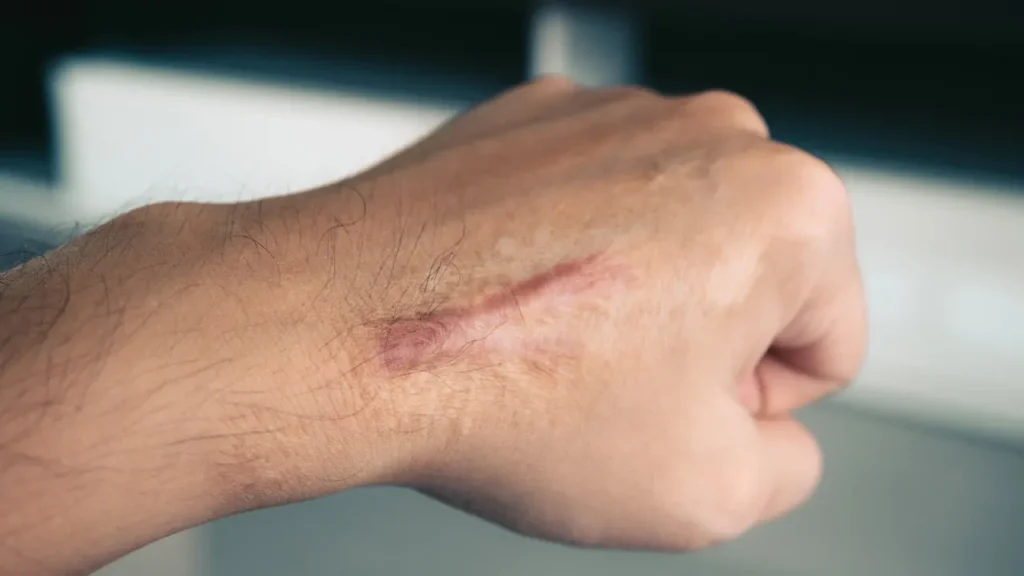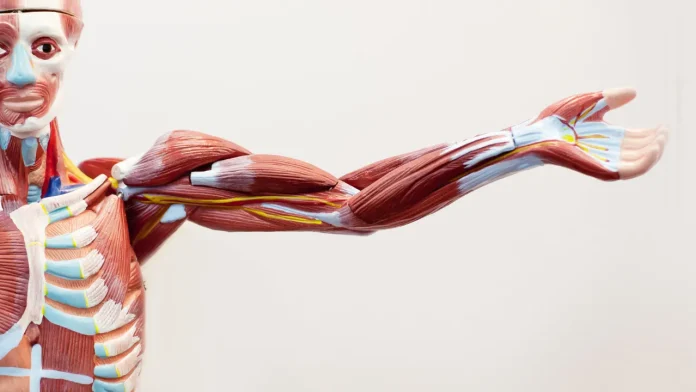From hiking and biking to working out at a gym, our muscles endure an impressive amount of action every day. While these activities are certainly good for the body’s health, these strenuous movements can place a lot of stress and strain on our muscles, with the risk of injury growing more prominent as we age or if we’re more reckless with our maneuvers. One form of muscle damage that could occur from overexertion is known as scarred muscle tissue.
Scarred muscle tissue, often referred to scientifically as muscular fibrosis, is a condition that can significantly impair one’s quality of life. Whether it results from injuries, surgery, or certain medical conditions, scarred tissue in muscles can lead to reduced flexibility and a compromised range of motion. However, while scarred muscle tissue can manifest through various means, there are also ways to help heal from its effects and even avoid it altogether. In this article, we will delve into the intricacies of scarred muscle tissue, exploring its causes, effects, and potential treatments for this challenging condition.
You May Also Like:
Support Your Heart Health: Comparing 2 Top Supplements
5 Great Ways Liquid Protein Supplements Can Take Your Fitness to the Next Level
Reduced Flexibility and Range of Motion: Discover the Challenges of Scarred Muscle Tissue is an original (OptimalHealthNews) article.
Understanding scarred muscle tissue
Scarred muscle tissue, scientifically termed “muscular fibrosis,” represents a complex physiological response to muscle injury or trauma. To comprehend this condition, it is essential to delve into the structural alterations that occur within muscle tissues as they heal. Scarred muscle tissue, characterized by the presence of excessive collagen fibers, significantly differs in composition and functionality from healthy muscle tissue.
When muscle fibers endure damage, whether through sudden trauma, surgical procedures, or chronic overuse, the body initiates a reparative process. The body’s natural response involves the recruitment of specialized cells called fibroblasts to the injured area. Fibroblasts play a pivotal role in the synthesis of collagen, a structural protein delegated to the task of tissue repair. In the context of muscle injuries, however, this reparative process can sometimes lead to the formation of an overabundance of collagen fibers. As collagen accumulates, it creates a dense matrix known as scar tissue, which replaces the normal muscle tissue.

Causes of scarred muscle tissue
Scarred muscle tissue can manifest as a result of various underlying causes, including traumatic events and medical conditions. Understanding the diversity of these triggers is crucial for effective management and prevention. Below, we expand upon the primary causes of scarred muscle tissue.
Traumatic Injuries: Trauma-induced muscle injuries, often sustained during accidents or intense physical activities, represent one of the most common causes of scarred muscle tissue. These injuries typically involve the overstretching or tearing of muscle fibers. The body responds by initiating an inflammatory process that includes the recruitment of immune cells and fibroblasts to repair the damaged tissue. However, if the healing process becomes dysregulated or excessive, it can result in the accumulation of collagen fibers, forming scar tissue.
Surgical Procedures: Surgery involving muscle tissues, such as orthopedic or cardiac procedures, may require the cutting of muscle fibers. While surgery is often essential for various medical conditions, it inadvertently triggers the formation of scar tissue in the operated area. Surgeons make every effort to minimize damage to muscle fibers during surgical interventions, but scar tissue formation remains an inherent part of the healing process. In cases where surgical trauma is extensive, or the healing process is disrupted, excessive scar tissue can develop, contributing to postoperative complications.
Medical Conditions: Certain medical conditions and diseases can predispose individuals to scarred muscle tissue. Muscular dystrophy, for instance, is a group of genetic disorders characterized by progressive muscle degeneration and weakness. Over time, as muscle fibers degenerate and repair mechanisms are activated, scar tissue can accumulate within affected muscles. Similarly, chronic inflammatory conditions like myositis, which involves muscle inflammation, can also lead to fibrosis within muscle tissues.
Effects of scarred muscle tissue
Understanding the effects of muscular fibrosis on the body is essential for comprehending the challenges it poses to individuals in their daily lives. Scarred tissue can bring about a multitude of physical consequences, ranging from functional limitations to discomfort.
Reduced Flexibility: Scar tissue in muscles has distinct mechanical properties compared to healthy muscle fibers. It is less pliable and lacks the natural elasticity of muscle tissue. Consequently, individuals with scarred muscle tissue often experience a pronounced reduction in flexibility. The impaired ability of scar tissue to stretch and adapt to different movements restricts the range of motion around joints and hampers muscle elongation. This limitation can make even simple activities, such as reaching overhead or bending to tie one’s shoes, challenging and uncomfortable.
Limited Range of Motion: The presence of scar tissue significantly restricts the range of motion (ROM) of the affected muscles. Damaged tissue prevents muscles from extending fully, limiting the extent to which a joint can move. As a result, individuals may struggle with tasks that require a full ROM, such as lifting objects, participating in sports, or even basic activities like dressing and grooming. Limited ROM can profoundly impact an individual’s independence and overall quality of life.
Pain and Discomfort: Scarred tissue within muscles can also be a source of pain and discomfort. The mechanical tension created by scar tissue can result in localized discomfort or aching sensations. In some cases, the presence of scar tissue may contribute to chronic pain, particularly if it affects the nerves or leads to muscle imbalances. Moreover, the discomfort associated with scarred muscle tissue can result in muscle guarding, a protective mechanism where the body limits movement in an effort to prevent further pain or injury. This can inadvertently exacerbate the problem and reduce flexibility.

The potential role of arginine in addressing scarred muscle tissue
Arginine, a semi-essential amino acid, has garnered attention in the context of scarred muscle tissue due to its potential role in encouraging tissue repair and regeneration. While it is not a direct treatment for muscular fibrosis, understanding its mechanisms and properties sheds light on how it may contribute to mitigating the effects of scarred muscle tissue.
Vasodilation and Blood Flow: Arginine is a precursor to nitric oxide (NO), a potent vasodilator. When arginine is metabolized, it can stimulate the release of NO, which, in turn, relaxes blood vessels and results in vasodilation. In the context of scarred muscle tissue, enhanced blood flow can play a beneficial role. Improved circulation aids in the delivery of vital nutrients, oxygen, and immune cells to the injured area, promoting efficient tissue repair. By facilitating the transportation of these essential components, arginine may help minimize the formation of excess scar tissue.
Collagen Synthesis and Extracellular Matrix Regulation: Collagen is a key structural component of scar tissue. Arginine’s influence on collagen synthesis and cellular regulation has been a subject of interest in scar tissue research. Some studies suggest that arginine may modulate collagen production and organization, potentially leading to more organized and less fibrotic scar tissue. While this aspect requires further investigation, it hints at arginine’s potential to influence the composition and quality of scar tissue.
Potential for Dietary Supplementation: Arginine can be obtained through dietary sources or supplements, making it accessible for individuals seeking to support their muscular health. Certain protein-based products contain arginine, among other amino acids, offering a convenient way to incorporate this amino acid into one’s diet.
Managing scarred muscle tissue
Effectively managing scarred muscle tissue involves a multifaceted approach that aims to improve functionality, reduce discomfort, and enhance overall quality of life. These management strategies encompass a range of clinical interventions, therapies, and lifestyle modifications tailored to each individual’s unique condition and needs.
Physical Therapy and Rehabilitation: Physical therapy plays a pivotal role in managing scarred muscle tissue. Skilled physical therapists design specialized exercise programs that target the affected muscles and surrounding tissues. These exercises are meticulously chosen to improve muscle flexibility, increase range of motion, and promote overall function. Therapists may employ various techniques, such as manual stretching, myofascial release, and proprioceptive neuromuscular facilitation (PNF), to break down scar tissue and restore muscle integrity.
Massage Therapy and Manual Techniques: Massage therapy, particularly myofascial release, can be a valuable adjunct to managing scarred muscle tissue. Myofascial release involves applying sustained pressure to the fascia, the connective tissue that surrounds muscles. This technique helps release tension within the fascia and scar tissue, promoting better blood flow and tissue elasticity.
Diet and Nutrition: A balanced diet plays a fundamental role in supporting muscle health and recovery. Individuals with scarred muscle tissue should consider dietary modifications to ensure they receive the necessary nutrients for tissue repair. A diet rich in lean proteins, vitamins, and minerals, including amino acids like arginine, can help promote muscle regeneration and overall tissue health. Certain protein supplements, such as Frog Fuel Power Protein, contain these nutrients and can help stimulate the muscular regenerative process.
Frog Fuel Power Protein is a liquid collagen shot that provides 15 grams of GMO-free protein within a portable packet, making it easy to ingest the nutrient-rich formula at any time of the day. This protein packet also contains a host of other impressive vitamins and minerals, including alanine, a muscle builder and immune strengthener; lysine, a compound that turns fatty acids into usable energy; and valine, a nutrient that increases endurance. As such, Frog Fuel’s protein packet may act as an effective supplement, potentially controlling and reducing scarred muscular tissue alongside other clinical measures.
Surgical Interventions: In some cases, surgical interventions may become necessary to address extensive or chronically problematic scar tissue. Surgical procedures can involve the removal of excessive scar tissue or the release of contractures, which are situations where scar tissue tightens around a joint and limits mobility. These interventions are typically considered when scarred muscle tissue significantly impairs function and non-surgical therapies have proven insufficient. Surgical decisions should be made in consultation with orthopedic surgeons or specialists with expertise in scar tissue management.
Pain Management: Scarred muscle tissue can often lead to chronic pain or discomfort. Pain management strategies may include non-prescription pain relievers, physical modalities like heat or cold therapy, or even prescription medications if necessary.

Prevention of scarred muscle tissue
Preventing scarred muscle tissue, or muscular fibrosis, is an essential goal that can significantly improve overall health and quality of life. While some instances of scar tissue formation are unavoidable due to surgical procedures or underlying medical conditions, proactive measures can help reduce the risk of developing this condition.
Proper Warm-Up and Stretching: One of the most effective ways to prevent scarred muscle tissue is to prioritize warm-up and stretching routines before engaging in physical activities or exercises. Warming up gradually increases blood flow to the muscles, making them more pliable and less prone to injury. Dynamic stretching exercises, which involve controlled movements that mimic the activity you are about to perform, can prepare the muscles for action. Static stretching exercises, held for 15-30 seconds per muscle group, can help improve flexibility and reduce the risk of muscle strain.
Maintaining Proper Posture: Good posture is essential for preventing unnecessary strain on muscles, which can lead to injuries and, subsequently, scarred muscle tissue. Individuals should be mindful of their posture when sitting, standing, and lifting. Ergonomic adjustments in the workplace or at home, such as using ergonomic chairs and proper lifting techniques, can further reduce the risk of muscle imbalances and injuries. Proper posture ensures that muscles and joints are functioning optimally, minimizing the risk of muscular fibrosis.
Gradual Progression in Exercise: Avoiding overexertion and allowing the muscles to adapt gradually to increased physical demands can significantly reduce the risk of scarred muscle tissue. When starting a new exercise regimen or engaging in strenuous physical activities, it’s important to progress slowly and avoid pushing the muscles beyond their limits. Overexertion can lead to muscle tears and injuries, which may result in scar tissue formation during the healing process. Following a structured and well-designed exercise program that considers individual fitness levels and goals can help prevent unnecessary muscle damage.
Prompt Treatment of Injuries: In the event of an injury, seeking prompt medical attention and adhering to recommended treatment protocols is crucial. Delayed or inadequate treatment of muscle injuries can increase the risk of excessive scar tissue formation. Healthcare professionals can provide guidance on appropriate measures to facilitate optimal healing, which may include rest, physical therapy, and pain management strategies.
Train for muscular longevity and wellness
Muscular fibrosis is a condition that can hinder one’s quality of life, limiting flexibility and range of motion compared to those without the condition. While there is no guaranteed cure, various medical strategies, such as physical therapy, massage therapy, and proper supplements and nutrition, can help target scarred muscle tissue and reduce its effects. Better still, by knowing how to take care of your body before, during, and after workouts, you may greatly reduce the chances of developing scarred tissue in the first place.
All things considered, adequate exercise is still the greatest means of improving your physical fitness and overall wellness. However, doing so while establishing healthy boundaries is crucial to optimize each and every workout while maximizing your gains. Keeping this in mind is imperative as you continue on your journey to holistic wellness.

Additional Reading:
SELF: How to Start Exercising Again When It’s Been…a While
Ace: 4 Stretches to Prevent Injury
Health: 7 Muscle Recovery Foods for After Your Next Workout
Piedmont: Why Is Protein Important in Your Diet?
Everyday Health: Post-Workout Muscle Recovery: How to Let Your Muscles Heal and Why
Important Note: The information contained in this article is for general informational purposes only, and should not be construed as health or medical advice, nor is it intended to diagnose, prevent, treat, or cure any disease or health condition. Before embarking on any diet, fitness regimen, or program of nutritional supplementation, it is advisable to consult your healthcare professional in order to determine its safety and probable efficacy in terms of your individual state of health.
Regarding Nutritional Supplements Or Other Non-Prescription Health Products: If any nutritional supplements or other non-prescription health products are mentioned in the foregoing article, any claims or statements made about them have not been evaluated by the U.S. Food and Drug Administration, and such nutritional supplements or other health products are not intended to diagnose, treat, cure, or prevent any disease.
